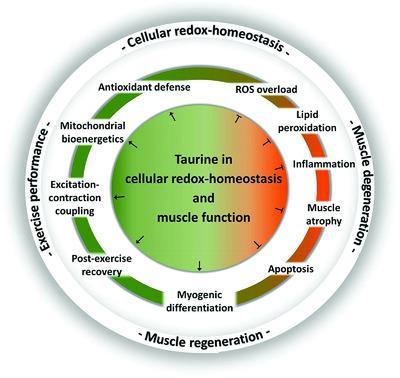当前位置:
X-MOL 学术
›
Mol. Nutr. Food Res.
›
论文详情
Our official English website, www.x-mol.net, welcomes your
feedback! (Note: you will need to create a separate account there.)
Taurine: A Regulator of Cellular Redox Homeostasis and Skeletal Muscle Function.
Molecular Nutrition & Food Research ( IF 4.5 ) Pub Date : 2018-10-07 , DOI: 10.1002/mnfr.201800569 Ulrike Seidel 1 , Patricia Huebbe 1 , Gerald Rimbach 1
Molecular Nutrition & Food Research ( IF 4.5 ) Pub Date : 2018-10-07 , DOI: 10.1002/mnfr.201800569 Ulrike Seidel 1 , Patricia Huebbe 1 , Gerald Rimbach 1
Affiliation

|
Taurine is a nonproteinogenic ß‐aminosulfonic acid. Important dietary sources of taurine are fish and seafood. Taurine interacts with ion channels, stabilizes membranes, and regulates the cell volume. These actions confirm its high concentrations in excitable tissues like retina, neurons, and muscles. Retinal degeneration, cardiomyopathy, as well as skeletal muscle malfunction are evident in taurine‐deficient phenotypes. There is evidence that taurine counteracts lipid peroxidation and increases cellular antioxidant defense in response to inflammation. In activated neutrophils, taurine reacts with hypochloric acid to form taurine chloramine, which triggers the Kelch‐like ECH‐associated protein 1–nuclear factor E2‐related factor 1 (Keap1–Nrf2) pathway. Consequently, Nrf2 target genes, such as heme oxygenase‐1 and catalase, are induced. Furthermore, taurine may prevent an overload of reactive oxygen species (ROS) directly by an inhibition of ROS generation within the respiratory chain. Taurine affects mitochondrial bioenergetics and taurine‐deficient mice exhibit an impaired exercise performance. Moreover, some studies demonstrate that taurine enhances the glycogen repletion in the postexercise recovery phase. In the case of taurine deficiency, many studies observed a phenotype known in muscle senescence and skeletal muscle disorders. Overall, taurine plays an important role in cellular redox homeostasis and skeletal muscle function.
中文翻译:

牛磺酸:细胞氧化还原稳态和骨骼肌功能的调节剂。
牛磺酸是一种非蛋白的β-氨基磺酸。牛磺酸的重要饮食来源是鱼和海鲜。牛磺酸与离子通道相互作用,稳定膜并调节细胞体积。这些作用证实了其在视网膜,神经元和肌肉等兴奋性组织中的高浓度。在牛磺酸缺乏的表型中,视网膜变性,心肌病和骨骼肌功能异常很明显。有证据表明,牛磺酸可抵抗脂质过氧化反应并在炎症反应中增强细胞的抗氧化防御能力。在活化的中性粒细胞中,牛磺酸与次氯酸反应形成牛磺酸氯胺,从而触发了Kelch样ECH相关蛋白1-核因子E2相关因子1(Keap1-Nrf2)途径。因此,诱导了Nrf2靶基因,如血红素加氧酶-1和过氧化氢酶。此外,牛磺酸可通过抑制呼吸链内ROS的产生直接防止活性氧(ROS)的超载。牛磺酸会影响线粒体的生物能,牛磺酸缺乏的小鼠运动能力受损。此外,一些研究表明牛磺酸在运动后恢复阶段增强了糖原的补充。在牛磺酸缺乏的情况下,许多研究观察到在肌肉衰老和骨骼肌疾病中已知的表型。总体而言,牛磺酸在细胞氧化还原稳态和骨骼肌功能中起重要作用。一些研究表明,牛磺酸可在运动后恢复阶段增强糖原的补充。在牛磺酸缺乏的情况下,许多研究观察到在肌肉衰老和骨骼肌疾病中已知的表型。总体而言,牛磺酸在细胞氧化还原稳态和骨骼肌功能中起重要作用。一些研究表明,牛磺酸可在运动后恢复阶段增强糖原的补充。在牛磺酸缺乏的情况下,许多研究观察到在肌肉衰老和骨骼肌疾病中已知的表型。总体而言,牛磺酸在细胞氧化还原稳态和骨骼肌功能中起重要作用。
更新日期:2018-10-07
中文翻译:

牛磺酸:细胞氧化还原稳态和骨骼肌功能的调节剂。
牛磺酸是一种非蛋白的β-氨基磺酸。牛磺酸的重要饮食来源是鱼和海鲜。牛磺酸与离子通道相互作用,稳定膜并调节细胞体积。这些作用证实了其在视网膜,神经元和肌肉等兴奋性组织中的高浓度。在牛磺酸缺乏的表型中,视网膜变性,心肌病和骨骼肌功能异常很明显。有证据表明,牛磺酸可抵抗脂质过氧化反应并在炎症反应中增强细胞的抗氧化防御能力。在活化的中性粒细胞中,牛磺酸与次氯酸反应形成牛磺酸氯胺,从而触发了Kelch样ECH相关蛋白1-核因子E2相关因子1(Keap1-Nrf2)途径。因此,诱导了Nrf2靶基因,如血红素加氧酶-1和过氧化氢酶。此外,牛磺酸可通过抑制呼吸链内ROS的产生直接防止活性氧(ROS)的超载。牛磺酸会影响线粒体的生物能,牛磺酸缺乏的小鼠运动能力受损。此外,一些研究表明牛磺酸在运动后恢复阶段增强了糖原的补充。在牛磺酸缺乏的情况下,许多研究观察到在肌肉衰老和骨骼肌疾病中已知的表型。总体而言,牛磺酸在细胞氧化还原稳态和骨骼肌功能中起重要作用。一些研究表明,牛磺酸可在运动后恢复阶段增强糖原的补充。在牛磺酸缺乏的情况下,许多研究观察到在肌肉衰老和骨骼肌疾病中已知的表型。总体而言,牛磺酸在细胞氧化还原稳态和骨骼肌功能中起重要作用。一些研究表明,牛磺酸可在运动后恢复阶段增强糖原的补充。在牛磺酸缺乏的情况下,许多研究观察到在肌肉衰老和骨骼肌疾病中已知的表型。总体而言,牛磺酸在细胞氧化还原稳态和骨骼肌功能中起重要作用。










































 京公网安备 11010802027423号
京公网安备 11010802027423号